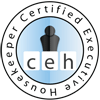An occasional cleaning by an absorbent material dampened with detergent and water will remove fine grit and dried matter that mars the appearance of a floor and can cause surface damage. A synthetic-head or cellulose “sponge” mop works well for households with small areas such as the kitchen, bathrooms, and hallways. These are available in a variety of absorbent head sizes and materials. They usually have a mechanism attached that squeezes excess solution from the absorbent material, leaving it damp. These mops are compact and easily stored.
Don’t waste money on small string mop heads. Buy at least a 24-ounce (680 g) head, preferably banded to keep the strings from getting tangled. Look for a handle that allows the mop to be easily turned over or changed. Handles come in different lengths. Chose one that matches the user’s height. Also, make certain the press and bucket are sized to fit the mop head of your choosing.
Mops spend most of their lives in detergent solution, so there is no reason they should be dirty or foul-smelling. Simply rinse them out well after use, press out the excess water, and place the mop head where air can circulate around all sides to dry it. Periodically rinsing string mopheads in a clean disinfectant solution and allowing to air dry will help control the growth of bacteria in the fibers. There is usually no need to wash string mop heads in a washing machine or bleach them white. The washing machine’s agitator is very likely to leave the mop strands hopelessly tangled, while bleaching will weaken the fibers. Mildew often forms on mop heads that remain damp too long, so be sure to leave the mop where it can dry thoroughly. Consider placing rinsed and squeezed-out string mop heads in your dryer (alone, without clothes) and tumbling dry at fairly high temperatures to help kill odor-causing bacteria and prevent the growth of mildew.
Whether cleaning with a string mop or sponge mop, keep an eye on the appearance of the mop head. It must be fairly clean itself, or it cannot remove soil from the floor. When the head is visibly soiled, return it to the solution-filled bucket and rinse thoroughly. The “sponge” mop is easily rinsed out under a faucet and squeezed dry by whatever press mechanism it has.
The rinse water and cleaning solution should be 'clean' for a string mop to do its job properly. A dirty mop head simply moves dirt around the floor instead of removing it to the bucket. It’s time to dump out dirty solution and re-fill the bucket once you can’t see a shiny coin, such as a quarter, at the bottom of the bucket. Prepare several gallons (at least 15 liters) of solution at a time to reduce the number of times you’ll need to change out the cleaner. Don’t attempt to rinse a string mop, even a small one, in just a few quarts (liters) of water.
Microfiber mops are another option well worth considering for damp mopping. See also Microfiber.
Caution: Never wet mop a "site-finished" hardwood floor with water or cleaning solution (damp mopping is fine if the finish is intact). Excess moisture may damage the sealer and permanently discolor the wood. Laminate floors may be damp mopped, but not wet mopped. It's OK to dry mop all of these surfaces with a microfiber or dust mop.









